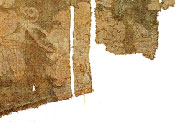 |
 |
|||||||||||||||||
 |
||||||||||||||||||
 |
||||||||||||||||||
| Classified Glossary | ||||||||||||||||||
 |
||||||||||||||||||
 |
||||||||||||||||||
| 15. 1Patterned textile On a patterned textile, we can identify the ground weave (dibuzuzhi), the patterning weave (tihuazuzhi), and patterned weave (huabuzuzhi). Note that the patterning weave is not always same as the patterned weave and foundation weave not same as the ground weave, both formers are structurally but the only for the design. Manipulating the warp to create the pattern is referred to as warp-patterned (jingxianhua), the weft to create weft-patterned (weixianhua), sometimes also uses a warp-faced or weft-faced weave. Decoupure or step (tujie) is the smallest gradation of a design, usually indicated by the warp ends (warp decoupure, jingtujie) and weft passes (weft decoupure, weitujie). (see CIETA 1964) 16. 1Self-patterned Using one set of warp and weft to create the ground and pattern, commonly used to describe patterned textiles using a warp and weft of the same colour. Self-patterned textiles (dancengtihuazhiwu) could be divided based on the different ground structure into three categories: damask on tabby, twill damask and satin damask. 17. 1Damask on tabby Patterned textile on a tabby ground in Chinese is called qi, often translated into different names in English, like Han damask. The author suggests the term damask on tabby to represent this weave structure. Damask on tabby appeared first in Shang Dynasty, most commonly as 1. tabby with floats (fuwenqi); in Han dynasty, 2. tabby with alternating floats (hanqi); 3. tabby with G-G weaves (fudianqi) in Tang and Liao dynasty; and 4. tabby with alternating wefts (jiaosuoling) in Tang and Song. These are all woven in the G-G method or 2-2 method (bingsizhifa). Damask on tabby has acquired different names during different periods in Chinese history, ling in the Tang and Song dynasties, and chou in the Ming and Qing dynasties. |
||||||||||||||||||
| THE BOOK | ||||||||||||||||||
| AUTHOR | ||||||||||||||||||
| CONTENTS | ||||||||||||||||||
| ORDER | ||||||||||||||||||
| CONTACT | ||||||||||||||||||
| LINKS | ||||||||||||||||||